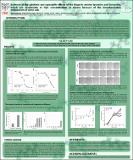Por favor, use este identificador para citar o enlazar a este item:
http://hdl.handle.net/10261/187232COMPARTIR / EXPORTAR:
 SHARE
BASE SHARE
BASE
|
|
| Visualizar otros formatos: MARC | Dublin Core | RDF | ORE | MODS | METS | DIDL | DATACITE | |

| Título: | Evidence of the cytotoxic and synergistic effects of the biogenic amines tyramine and histamine, which can accumulate at high concentrations in cheese because of the decarboxylative metabolism of some LAB |
Autor: | Río Lagar, Beatriz del CSIC ORCID ; Redruello, Begoña CSIC ORCID; Linares, Daniel M. CSIC; Ladero Losada, Víctor Manuel CSIC ORCID ; Fernández García, María CSIC ORCID ; Martín, M. Cruz CSIC ORCID ; Ruas-Madiedo, Patricia CSIC ORCID ; Álvarez González, Miguel Ángel CSIC ORCID | Fecha de publicación: | 27-ago-2017 | Citación: | 12th International Symposium on Lactic Acid Bacteria (2017) | Resumen: | Lactic acid bacteria (LAB) play an essential role in the production of a large diversity of fermented foods. The long and harmless history of use of LAB in food fermentations has resulted in them being generally recognized as safe. However, some LAB possess enzymatic activities that produce undesirable toxic compounds, such as the biogenic amines (BA) tyramine and histamine. In cheese, one of the foods in which the highest concentrations of BA can be found, they are produced predominantly by LAB. More specifically, Enterococcus faecalis is the main responsible for the accumulation of tyramine, while Lactobacillus parabuchneri is the species mainly responsible for the accumulation of histamine. Although the European Food Safety Authority (EFSA) deems tyramine and histamine to be the most toxic BA, it also concludes that our present knowledge of their toxicity is limited, and that further research is needed. In this communication, we present an analysis of the in vitro cytotoxicity of tyramine and histamine, individually and in combination, towards intestinal cells in culture. To perform these analyses, we have developed an in vitro model of the human intestinal epithelium based on the HT29 cell line and the Real Time Cell Analyzer (RTCA) technology. Tyramine and histamine were found to be cytotoxic at concentrations commonly found in some types of cheese. Surprisingly, tyramine -a BA for which no legal limit has been established- had a stronger and more rapid cytotoxic effect than histamine. Their mode of action was also different, while tyramine caused cell necrosis, histamine induced apoptosis. We further found that tyramine and histamine have synergistic cytotoxicity in the range of concentrations that can be found in foods. | Descripción: | Trabajo presentado en el 12th International Symposium on Lactic Acid Bacteria, celebrado en Egmond aan Zee (Holanda) del 27 al 31 de agosto de 2017 | URI: | http://hdl.handle.net/10261/187232 |
| Aparece en las colecciones: | (IPLA) Comunicaciones congresos |
Ficheros en este ítem:
| Fichero | Descripción | Tamaño | Formato | |
|---|---|---|---|---|
| Evidence _cytotoxic.pdf | 4,85 MB | Adobe PDF |  Visualizar/Abrir |
CORE Recommender
Page view(s)
178
checked on 18-abr-2024
Download(s)
71
checked on 18-abr-2024
Google ScholarTM
Check
NOTA: Los ítems de Digital.CSIC están protegidos por copyright, con todos los derechos reservados, a menos que se indique lo contrario.
